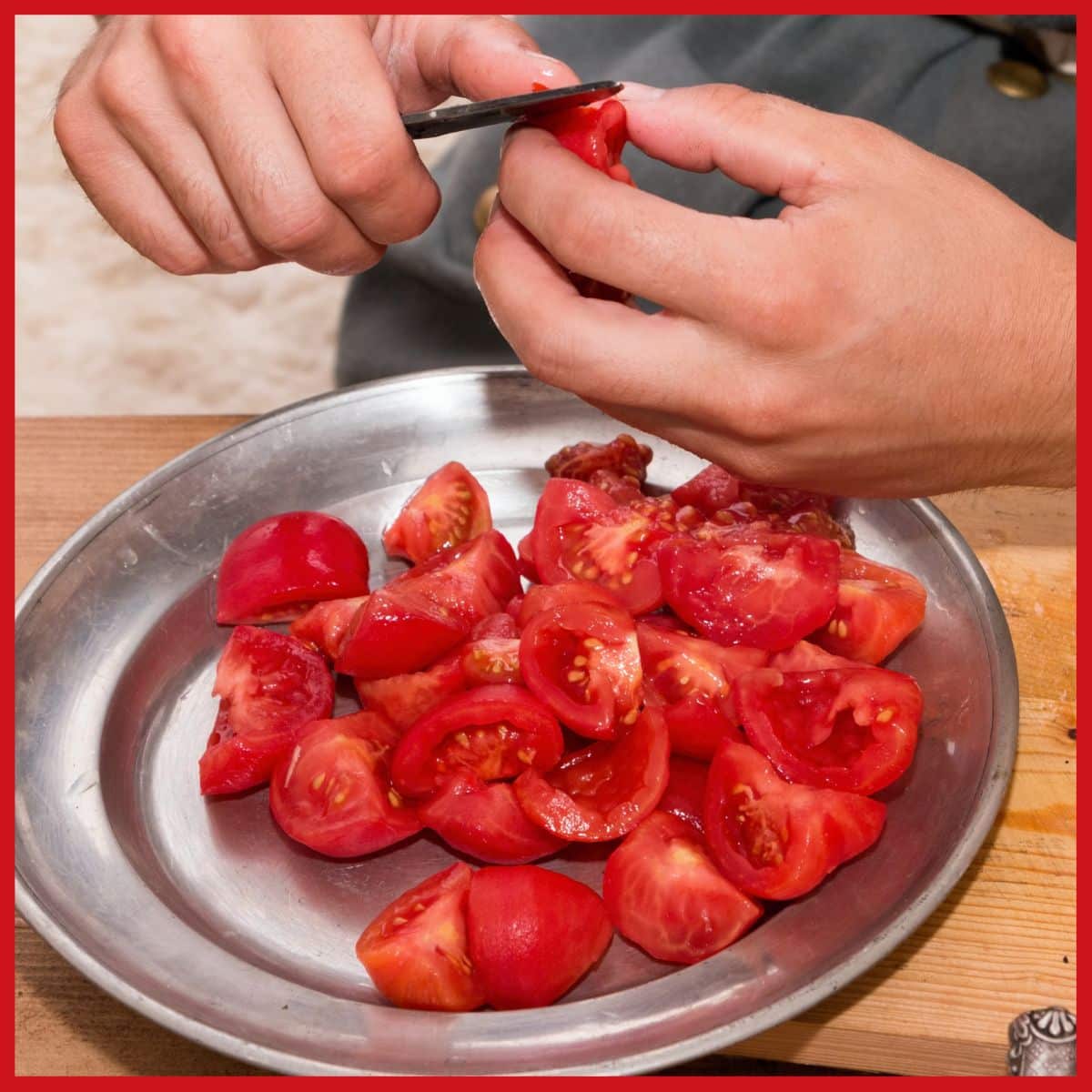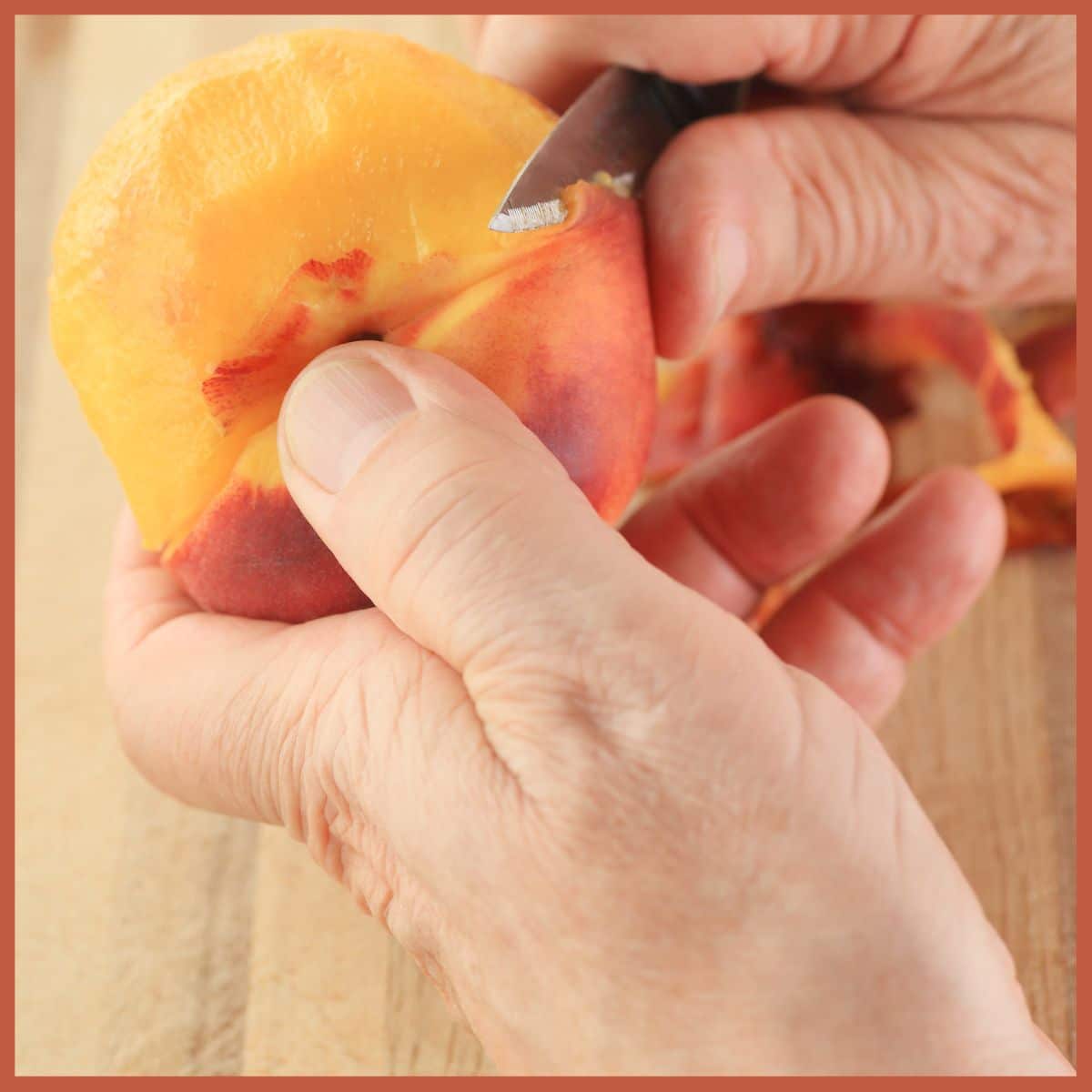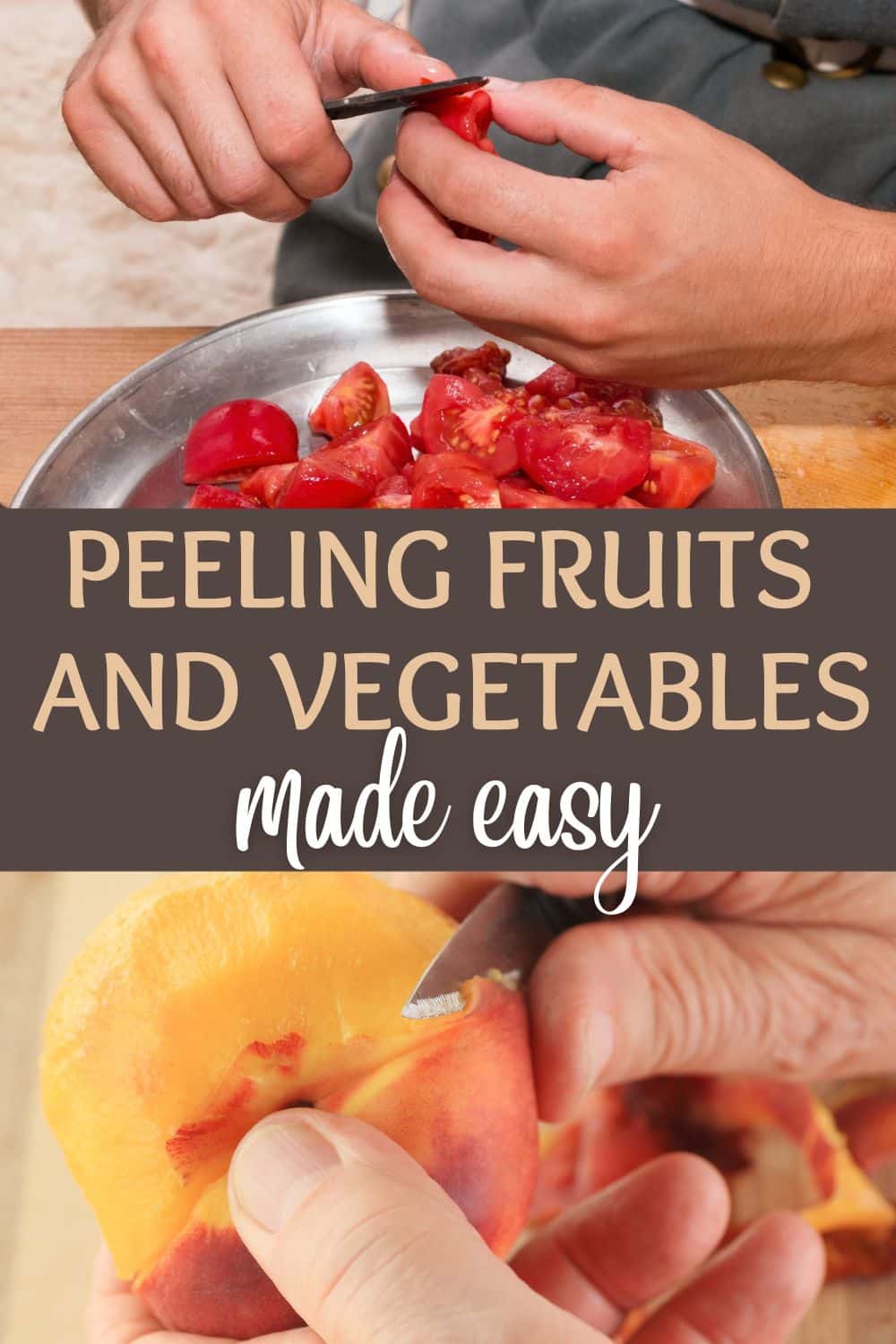Should you be peeling fruits and vegetables? When needed, it is simple when you use this little trick of the boiling water technique. Have you ever wished you could find a quicker way to peel your fruits and veggies in the kitchen?
Peeling fruit can feel like a chore but some occasions call for it. And the same can be said about peeling vegetables. But what if there was a way to learn how to peel vegetables and how to peel fruit that was both easy and efficient? Let's explore!

Reasons for Peeling Fruits and Vegetables
First, let's take a look at some reasons you may want to peel your fruits and veggies.
Why don't we just leave it all on there? Why do we peel vegetables?
Sometimes, it's because the skin or peel is not edible. In these cases, it is necessary to peel the vegetable to get to the edible part inside.
But most of the time, we peel fruits or veggies because of personal preference. Although we can eat the banana peel, for example, most people find it too tough and not very tasty.
Citrus fruits are another one where we usually don't eat the peels. They are edible, and you can use them in cooking, as a zest, or in other creative ways but most people don't want to just eat citrus skin.
They are tough and difficult to chew and don't have a nice flavor. This is why we peel certain fruits and vegetables.
Have you ever wondered if there is an easy way to get the peel off of fruits and vegetables that have thin skins? Oranges, heck, they are easy. Nice thick skin that separates easily from the fruit underneath.
But peaches!? That thin, fuzzy skin is stuck tight to the fruit beneath it, isn't it? Or tomatoes?

But you don't always want to peel your veggies or fruits. Why should you avoid peeling fruits and vegetables? Well, in many cases, the peel has a lot of added nutrients and if you remove that, you're losing out on some of the most nutritious parts of the food.
possible, you want to keep those skins on. But when they need to go, there are plenty of methods to help you pull it off.
Methods of Peeling Fruits and Vegetables
Working with fresh produce includes knowing the different methods of peeling fruits and vegetables, for when the need comes. The method you choose can vary based on personal preferences and how you will be preparing the food items.
For example, if something is cooked, or mixed in a blender, then you can work with it differently than if you were eating it raw, using it as a garnish or topping, or serving with the peel still on.
Here are the basics:
- Conventional - these are the methods you do with your hands, a knife, a spoon, or other tools
- Mechanical - these are methods that involve using a machine made for this purpose
- Lye - this involves using lye to remove skins as they tumble in a solution bath
- Steam peeling - as the name suggests, using steam to help peel the skin off of veggies and fruits
- Flame peeling - this requires heat/flame to remove the skin and peels and works by charring it off
There are also more intricate methods for peeling fruits, such as ultrasonic peeling, ohmic and enzymatic peeling. These are not used in a typical family kitchen, but they might be used in a professional kitchen setting.
Here's the trick for peaches and tomatoes
Bring a pot of water to boiling - a full rolling boil with enough water to completely cover the fruit. Drop those peaches into the pot for about a minute. You'll know when to lift them out with a slotted spoon when you can gently rub the skin with the spoon and see it separate from the fruit.
Immediately douse them with ice water to stop the cooking. When cool enough to safely handle, just grab the skin and peel it off like unwrapping a piece of candy.
The boiling water technique works for tomatoes much the same way as it does for peaches. With the tomatoes, you can see blisters form as the skin separates from the meat underneath.
Some vegetables like beets are best cooked in boiling water until they are tender and ready to serve. Then plunge them into the cold water and the skins will fall off in your hand. Well, maybe a little tug here and there.
What other fruits and veggies can you skin with the boiling water technique?
What you need
You'll need a good set of pans and a paring knife.
How to Peel Fruit - Tips and Tricks
When peeling fruit, here are some tips:
- use the edge of a spoon for many fruits to lift the peel easier (this works well for kiwi)
- learn fruit-specific tricks to make it easier
- practice and get a "feel" for the best way to peel them
How to Peel Vegetables - Tips and Tricks
When peeling veggies, here are some tips:
- always wash before peeling
- use sharp, durable kitchen knives
- peel vegetables thinly and as close to the skin as possible
- for veggies like potatoes and beets, you can boil them first to loosen the skin
- with carrots and similar, start on the bigger end first
Fruits and Veggies to Eat the Peels If You Can
Here are some you will want to eat the peels of, whenever you can:
- apples
- potatoes
- cucumbers
- kiwi
- eggplant
- carrots
- mango
- watermelon
- lemons
- limes
- oranges - when prepared, such as by cooking the skin
They have so many great nutrients for you. Some of these you may not have known you could eat. In many cases, a fruit peel has increased antioxidant levels, helping you fight illness and disease. Lemon peels are often used in cooking or as a drink garnish and some unpeeled fruits are traditionally eaten whole, like apples.
What Fruits and Vegetables Do you Peel?
And here are some peels you don't want to eat:
- pineapple
- papaya
- banana
- mango
- lychee
- avocado
- onion
- garlic
- butternut squash
In general, you don't want to eat the peels of tropical fruits. Some of these you can eat, but they can be tough to chew, so you may want to prepare them in a way that makes it easier, or blend them into a smoothie. Avocado skins are usually peeled before eating the fruit inside, but many people will put some skin inside a smoothie that will be blended up anyway.
Peeling Fruits and Vegetables FAQ
Here are some more questions people sometimes ask about peeling veggies and fruits.
Should we peel cucumber?
No, you don't have to peel cucumber. Much like potato peels, they contain nutrients if you keep them on.
Should you peel grapes?
There is no reason to peel the skin off grapes before eating them. In fact, you may find it difficult to accomplish, if you do try.
Should I remove apple skin?
You don't have to remove apple skin and most people don't. However, some people who do not like the taste of the skin of the apple, or have problems digesting, may prefer peeling it off before eating.
Are vegetable skins good for you?
Most of them, yes! With just a few exceptions, most vegetable skins actually have a lot of nutrients that are healthy for you, so eating them is encouraged.
Recipes Made With Fruits and Vegetables
- Fried Green Tomatoes
- Tomato Red Sauce
- Fresh Peach Pie
- Cinnamon Rice Pudding with Peaches
- Peach Crisp
- Summertime Peach Tart
RATE, PIN & SHARE!
Please Rate our recipes, and Pin and Share them on social media. Comments are welcome, too!

Kathy acquired the blog, Recipe Idea Shop in 2024. She was raised on a farm in Arkansas where having a big garden and good food to eat was the norm. She shares recipes for homemade comfort food and new trending dishes.
Kathy began her blogging journey in 2011 when she founded PetticoatJunktion.com, a home décor blog focused on repurposing and upcycling furniture, and thrift store finds.

